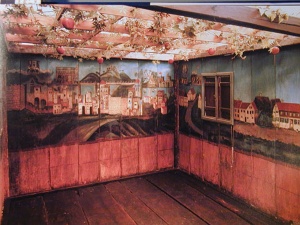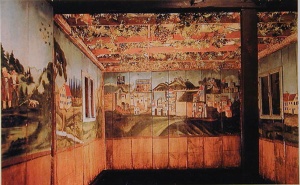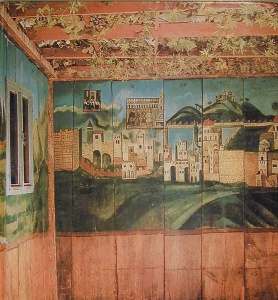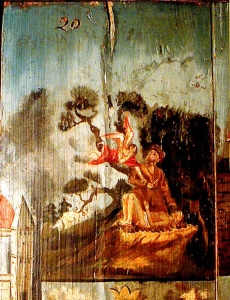At The Israel Museum
Ha’norah
On Shabbos evening I walked home on my normal route down Fifth Avenue towards Washington Square Park. Looking past the Washington Square Arch, slightly to the west and further downtown, I noticed a glow of lights and smoke illuminating the early evening sky. That was where the World Trade Center used to be.
The next day I walked all the way downtown to Maiden Lane and Broadway. It was a bright sunny day as the crowds of people lined the east side of Broadway to catch a glimpse of the ruin. Even over two weeks after the carnage the air still smelled of burning rubble. The police and National Guard wearing gas masks kept the crowd moving at a firm distance from the wreckage. There was a thick layer of dust on all the surrounding buildings and awnings. All we could see was the side of one burnt out and charred building and then, a block further down, the stark fragments of façade protruding from a mount of smoldering rubble. And blue sky above. That was where the World Trade Center used to be.
We walked away from the barricades on Broadway and started home. All I could think of was the thousands of people buried or incinerated a handful of blocks away from where I stood. There was an overwhelming sense of emptiness, loss and absence. I tried to distract myself and to focus on the Yom Tov of Succos a mere two days away. I thought about the succah we had just completed in my community and those who would decorate it soon.

Half a world away at the Israel Museum in Jerusalem there is a decorated succah from the early nineteenth century. It was created for the Deller family in the Bavarian town of Fischach, not far from Augsberg, Germany. Jews had been in this town at least since 1573 and maintained a prosperous presence until the early 1930s. It is comforting to know that through the centuries, in good times and bad, Jews made and decorated their succahs. The approximately thirty painted panels of the Deller family succah had been smuggled out of Germany in 1935 by packing them, painted side facing in, inside a wooden crate containing the personal possessions of the Fraenkel family as they immigrated to Israel.

At first the paintings seem to be a simple folk depiction of local houses and countryside. On closer examination they are a complex and heartfelt evocation of Jewish life in Southern Germany in the 1830s. To the right of the entrance wall there is a hunting scene with two well-dressed men and a dog looking up at ten birds flying overhead. It has been suggested that this is Abraham Deller and his son or the local Baron and his hunter. Whoever they may be, the panel evokes a family rooted and secure in their community. Opposite is a depiction of the town of Fischach and the Jewish quarter with its synagogue. Mrs. Deller stands in the doorway of her home ready to welcome guests, just as anyone would on the eve of this most communal of festivals.
The wall opposite the entrance is more complex pictorial program. It presents a schematic depiction of the Holy Sites of Jerusalem taken from a series of popular engravings by Yehosef Scharz published in 1836. This wall is a panoramic Folk Art depiction of the Dome of the Rock, the Al-Aqsa Mosque and the Wailing Wall set in an imaginary landscape. It operates as a kind of elaborate Mizrah to focus the inhabitants of the succah East to Jerusalem. Then one notices a series of three panels floating over the sacred landscapes below. Two other similar panels are also floating over the local landscape directly to the right. These five scenes depict the five major Jewish holidays and were modeled on engravings by Joseph Herz in a deluxe machzor published in 1826 by Sechel Arnstein and Sons in Sulzbach.

By being on the “Jerusalem” wall these five panels are elevated in importance and stature. We must notice them and pay attention. They depict the following holidays; the Offering of the Korbon Pesach (Passover); Moses Receiving the Law atop Sinai (Shavous); the Kohen Gadol offering the Sacrifice on Yom Kippur (Yom Kippur); Jews marching around the bimah with Torah scrolls (Succos) and finally a depiction of the Sacrifice of Isaac (Rosh Hashana). It was this last panel that came to my mind as I tried to recover from the sadness and pain of visiting the site of the World Trade Center.

Isaac is shown lying on his back, bound, and his eyes blindfolded. Abraham stands over Isaac with the knife poised to slaughter his son. An angel has appeared and has grasped Abraham’s arm holding the knife. Abraham looks up at the angel in surprise. The angel cannot bear to watch and has covered his eyes.
Who could bear to have such an image in his succah? This simple folk depiction breaks our hearts as it reminds us of u’nesaneh tokef in the Rosh Hashanah mussaf; “Who will live and who will die; who will die at his predestined time and who before his time…”
All of us, no matter what decorates the succah we are in this Yom Tov, will have this image in our mind’s eye. We cannot bear nor forget the images of the destruction of the World Trade Center, the images of the empty crater, the smoking ruins, the images of emptiness, loss and absence. And all we can do is to believe with all our hearts that our prayer of “But repentance, prayer and charity remove the evil of the decree!” will be fulfilled in the year to come. (I am indebted to the article on the Deller Succah by Naomi Feuchtwanger-Sarig published in Jewish Art, Volume 19/20, 1993-1994)